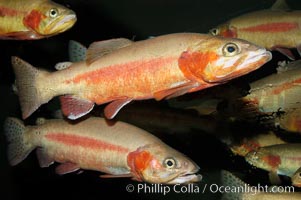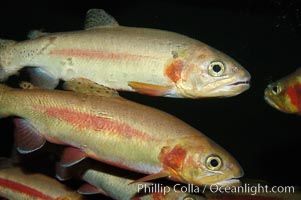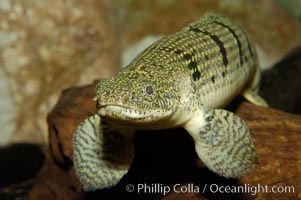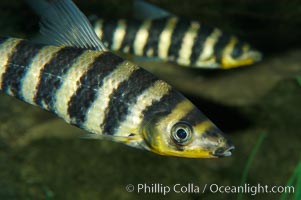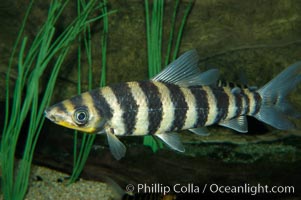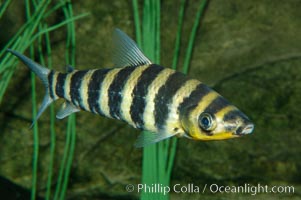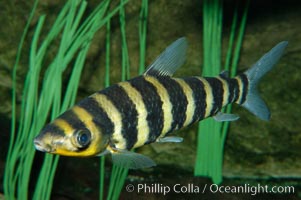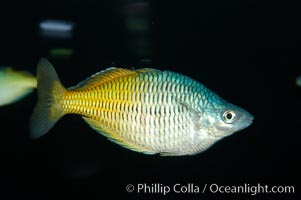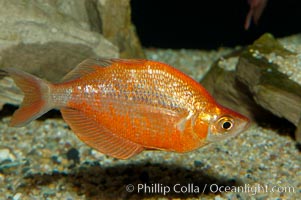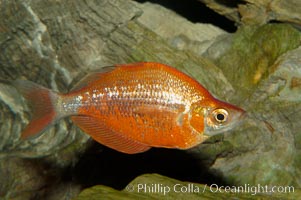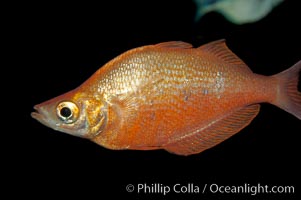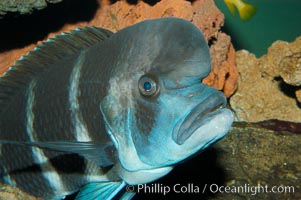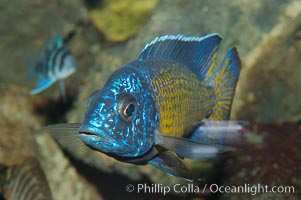
Unidentified African cichlid fish.
Image ID: 09262
Image ID: 09262
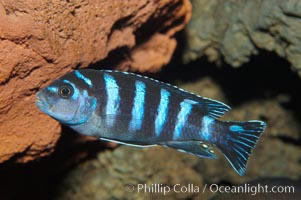
Unidentified African cichlid fish.
Image ID: 09263
Image ID: 09263
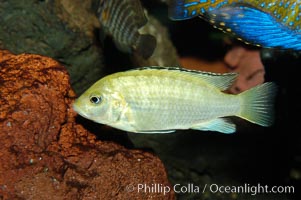
Unidentified African cichlid fish.
Image ID: 09264
Image ID: 09264
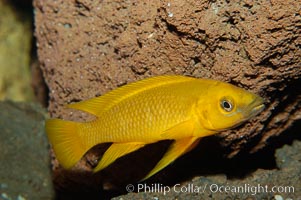
Unidentified African cichlid fish.
Image ID: 09265
Image ID: 09265
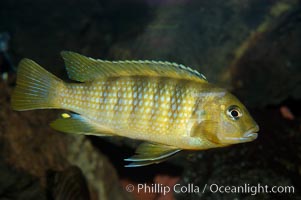
Unidentified African cichlid fish.
Image ID: 09266
Image ID: 09266
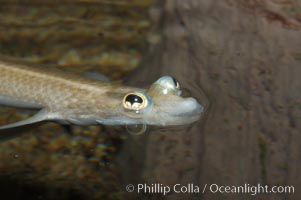
Four-eyed fish, found in the Amazon River delta of South America. The name four-eyed fish is actually a misnomer. It has only two eyes, but both are divided into aerial and aquatic parts. The two retinal regions of each eye, working in concert with two different curvatures of the eyeball above and below water to account for the difference in light refractivity for air and water, allow this amazing fish to see clearly above and below the water surface simultaneously.
Species: Four-eyed fish, Anableps anableps
Image ID: 09276
Species: Four-eyed fish, Anableps anableps
Image ID: 09276
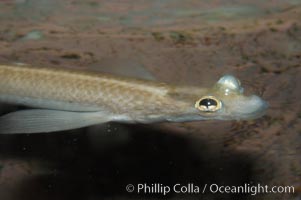
Four-eyed fish, found in the Amazon River delta of South America. The name four-eyed fish is actually a misnomer. It has only two eyes, but both are divided into aerial and aquatic parts. The two retinal regions of each eye, working in concert with two different curvatures of the eyeball above and below water to account for the difference in light refractivity for air and water, allow this amazing fish to see clearly above and below the water surface simultaneously.
Species: Four-eyed fish, Anableps anableps
Image ID: 09277
Species: Four-eyed fish, Anableps anableps
Image ID: 09277
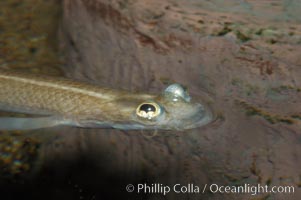
Four-eyed fish, found in the Amazon River delta of South America. The name four-eyed fish is actually a misnomer. It has only two eyes, but both are divided into aerial and aquatic parts. The two retinal regions of each eye, working in concert with two different curvatures of the eyeball above and below water to account for the difference in light refractivity for air and water, allow this amazing fish to see clearly above and below the water surface simultaneously.
Species: Four-eyed fish, Anableps anableps
Image ID: 09278
Species: Four-eyed fish, Anableps anableps
Image ID: 09278
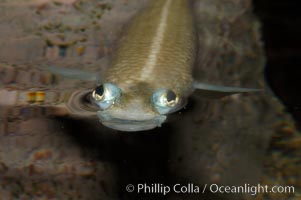
Four-eyed fish, found in the Amazon River delta of South America. The name four-eyed fish is actually a misnomer. It has only two eyes, but both are divided into aerial and aquatic parts. The two retinal regions of each eye, working in concert with two different curvatures of the eyeball above and below water to account for the difference in light refractivity for air and water, allow this amazing fish to see clearly above and below the water surface simultaneously.
Species: Four-eyed fish, Anableps anableps
Image ID: 09279
Species: Four-eyed fish, Anableps anableps
Image ID: 09279
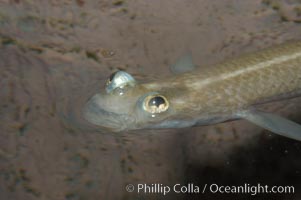
Four-eyed fish, found in the Amazon River delta of South America. The name four-eyed fish is actually a misnomer. It has only two eyes, but both are divided into aerial and aquatic parts. The two retinal regions of each eye, working in concert with two different curvatures of the eyeball above and below water to account for the difference in light refractivity for air and water, allow this amazing fish to see clearly above and below the water surface simultaneously.
Species: Four-eyed fish, Anableps anableps
Image ID: 09280
Species: Four-eyed fish, Anableps anableps
Image ID: 09280
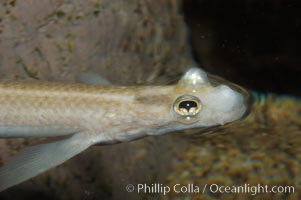
Four-eyed fish, found in the Amazon River delta of South America. The name four-eyed fish is actually a misnomer. It has only two eyes, but both are divided into aerial and aquatic parts. The two retinal regions of each eye, working in concert with two different curvatures of the eyeball above and below water to account for the difference in light refractivity for air and water, allow this amazing fish to see clearly above and below the water surface simultaneously.
Species: Four-eyed fish, Anableps anableps
Image ID: 09281
Species: Four-eyed fish, Anableps anableps
Image ID: 09281
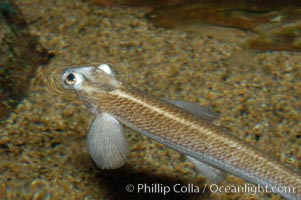
Four-eyed fish, found in the Amazon River delta of South America. The name four-eyed fish is actually a misnomer. It has only two eyes, but both are divided into aerial and aquatic parts. The two retinal regions of each eye, working in concert with two different curvatures of the eyeball above and below water to account for the difference in light refractivity for air and water, allow this amazing fish to see clearly above and below the water surface simultaneously.
Species: Four-eyed fish, Anableps anableps
Image ID: 09282
Species: Four-eyed fish, Anableps anableps
Image ID: 09282
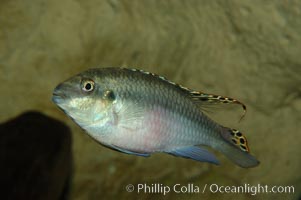
Unidentified freshwater fish.
Image ID: 09294
Image ID: 09294
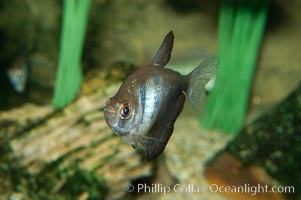
Unidentified freshwater fish.
Image ID: 09295
Image ID: 09295
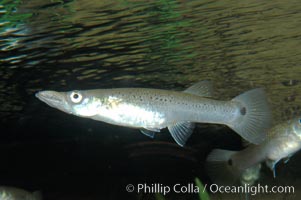
Unidentified freshwater fish.
Image ID: 09296
Image ID: 09296
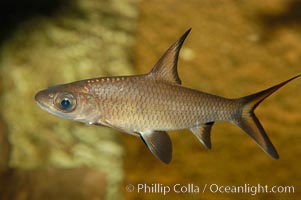
Bala shark, a freshwater fish native to the rivers of Thailand, Borneo and Sumatra, grows to about 14 inches long.
Species: Bala shark, Balantiocheilus melanopterus
Image ID: 09321
Species: Bala shark, Balantiocheilus melanopterus
Image ID: 09321
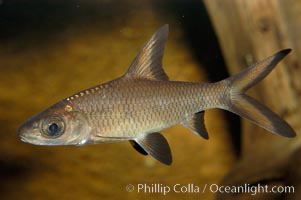
Bala shark, a freshwater fish native to the rivers of Thailand, Borneo and Sumatra, grows to about 14 inches long.
Species: Bala shark, Balantiocheilus melanopterus
Image ID: 09322
Species: Bala shark, Balantiocheilus melanopterus
Image ID: 09322
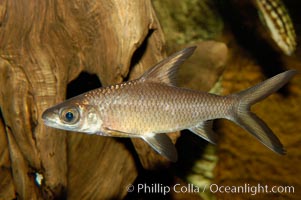
Bala shark, a freshwater fish native to the rivers of Thailand, Borneo and Sumatra, grows to about 14 inches long.
Species: Bala shark, Balantiocheilus melanopterus
Image ID: 09323
Species: Bala shark, Balantiocheilus melanopterus
Image ID: 09323
